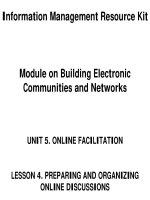UNIT 5. ONLINE FACILITATION LESSON 3. DEVELOPING YOUR ONLINE COMMUNITY CULTURENOTE doc
Bạn đang xem bản rút gọn của tài liệu. Xem và tải ngay bản đầy đủ của tài liệu tại đây (5.77 MB, 14 trang )
5. Online Facilitation - 3. Developing your online community culture - page 1
Information Management Resource Kit
Module on Building Electronic
Communities and Networks
UNIT 5. ONLINE FACILITATION
LESSON 3. DEVELOPING YOUR ONLINE
COMMUNITY CULTURE
© FAO, 2006
NOTE
Please note that this PDF version does not have the interactive features
offered through the IMARK courseware such as exercises with feedback,
pop-ups, animations etc.
We recommend that you take the lesson using the interactive courseware
environment, and use the PDF version for printing the lesson and to use as a
reference after you have completed the course.
5. Online Facilitation - 3. Developing your online community culture - page 2
At the end of this lesson, you will
be able to:
• identify factors influencing the
development of online community
cultures; and
• identify activities to enhance
online community culture.
Objectives
For an online group to be a “community”
it needs to be more than a collection of
individuals who have subscribed to a
mailing list.
Just as putting fifty people in a room
together doesn’t make them a
community, subscribing them to a list,
blog or online interaction space doesn’t
make them an online community.
Community is about the nature and
quality of relationships and
communication, and about shared
visions and commitment.
Introduction
5. Online Facilitation - 3. Developing your online community culture - page 3
Online communities develop their own
unique cultures, which evolve over the
course of shared activities, especially online
discussions.
Things like
• the level of group posting activity
• the formality/informality of message tone
• if and how humour is used
• the balance between social and task-
focused interaction
• the nature and extent of facilitation
all combine to shape the culture of the
online community.
Online community culture
COMMUNITY CULTURE
A broad definition of community/group culture is:
The collective beliefs, knowledge, traditions, habits and values that characterize a
community or group and regulate the way members interact with each other.
Here are some characteristics of culture:
• Culture evolves: culture is an accumulation of beliefs, traditions etc. which develop over
time, sometimes over thousands of years, sometimes over a shorter period. We can’t “plan”
or “legislate” a culture into existence: it develops and changes over time.
• Culture is learned, not something we are born with. Some elements of culture may be
formally taught, some elements we learn through observation.
• Cultural practices can be positive or negative. For example, we can speak of a
“supportive” organizational culture (evident where “supportiveness” is both valued and
practiced), or say that “corruption was embedded in the organizational culture”).
Just as “community” can apply to different types and sizes of groups so “culture” can be
applied to groups as diverse as religious groups, corporations, and online communities.
COMMUNITY CULTURE
A broad definition of community/group culture is:
The collective beliefs, knowledge, traditions, habits and values that characterize a
community or group and regulate the way members interact with each other.
Here are some characteristics of culture:
• Culture evolves: culture is an accumulation of beliefs, traditions etc. which develop over
time, sometimes over thousands of years, sometimes over a shorter period. We can’t “plan”
or “legislate” a culture into existence: it develops and changes over time.
• Culture is learned, not something we are born with. Some elements of culture may be
formally taught, some elements we learn through observation.
• Cultural practices can be positive or negative. For example, we can speak of a
“supportive” organizational culture (evident where “supportiveness” is both valued and
practiced), or say that “corruption was embedded in the organizational culture”).
Just as “community” can apply to different types and sizes of groups so “culture” can be
applied to groups as diverse as religious groups, corporations, and online communities.
Online community culture
5. Online Facilitation - 3. Developing your online community culture - page 4
One of the most significant factors influencing the development of online community
culture is previous relationships.
If some or all members already know each other from face-to-face interaction (or
other online communities) existing relationships will carry over onto the list and
affect the group dynamic.
In your opinion, do these relationships always influence the community culture
positively?
Yes
No
Please click on the answer of your choice
Previous relationships
Previous relationships
Imagine that some (not all) online community
members have worked together for many years.
They know each other already and relationships
are good.
Negatively
Positively
Both positively and negatively
Please click on the answer of your choice
How could this affect the online community culture?
5. Online Facilitation - 3. Developing your online community culture - page 5
Online interactions
In online groups, the way a group communicates from the start sets the tone
for what follows.
Effective facilitation is a significant enabler of effective communication.
Think of this as a cycle: the
habits and patterns of
communication influence the
culture of the group, which in
turn influences future
interaction…
habits and patterns of
communication
culture of the
group
future interaction
Online discussions are another significant factor influencing the culture of an online
community.
The manner in which discussions are facilitated or moderated, the extent to which
people feel free to express themselves, the quality of the discussion and management of
information flows, the sensitivity to differences such as gender, language and access,
and how this is managed, all contribute to shaping the culture of the online community.
Attending to the foundation
How to develop a sense of community
and enhance community culture?
The first step is to attend to the
foundations of the online community.
As an online facilitator, you first need
to ensure that participants understand,
share and are committed to
community goals and guidelines.
Let’s have a look at these important
issues
5. Online Facilitation - 3. Developing your online community culture - page 6
During the analysis and design stage of the
community building process, goals and
objectives have been stated together with
the stakeholders.
However, you should present a formal
version of goals and objectives to the
community for discussion.
If necessary, you should revise them based
on input from the community, and present
the final version for community approval.
Even if community members have agreed to
the group goals it may still be necessary to
balance different needs and goals.
Ongoing use of goals and objectives
STATED
GOALS
NEW
INPUTS
Balancing competing interests
Community members are individuals and also members of other communities
(organizations, cultures, families) with their own individual goals and needs, which may
affect interaction.
Community members may want to revise the project goals as more urgent issues
arise – while your donors might require you to follow the original goals and objectives
very closely.
Some community members may have a greater interest in certain aspects of the project
than in others.
Balance competing interests by
• Involving community members in goal setting, and ensuring that members are familiar
with the community’s goals and ground rules;
• Reminding members of the goals they have agreed to;
• Being as flexible as your circumstances allow: if it becomes clear that your goals are
not practical, or that there are more pressing needs, consider revising them. Listen to
the group and ensure that there is consensus before goals and objectives are changed.
Balancing competing interests
Community members are individuals and also members of other communities
(organizations, cultures, families) with their own individual goals and needs, which may
affect interaction.
Community members may want to revise the project goals as more urgent issues
arise – while your donors might require you to follow the original goals and objectives
very closely.
Some community members may have a greater interest in certain aspects of the project
than in others.
Balance competing interests by
• Involving community members in goal setting, and ensuring that members are familiar
with the community’s goals and ground rules;
• Reminding members of the goals they have agreed to;
• Being as flexible as your circumstances allow: if it becomes clear that your goals are
not practical, or that there are more pressing needs, consider revising them. Listen to
the group and ensure that there is consensus before goals and objectives are changed.
Ongoing use of goals and objectives
5. Online Facilitation - 3. Developing your online community culture - page 7
GOALS
Goals should not be developed and left to gather dust.
Communicate the community’s goals and objectives to people who
join it after the initial goal-setting process so that they know what
they are committing themselves to. Include information about the
community’s goals and objectives in the online information file which
is automatically sent to people who subscribe to your online
workspaces. If the community has a web page, ensure that the goals
are included in the text.
Remind all community members of the shared goals and objectives
from time to time, and “check in” on progress.
You will need to
Ongoing use of goals and objectives
Keeping the discussions relevant to the community’s goals and
objectives
In order to ensure that discussions are kept relevant to the community’s
original goals and objectives it is necessary to regularly revisit them.
Refer to your goals and objectives at key stages in the discussion: at the start
to make sure all participants know what they are aiming for within the
community, and at the end so that the community can evaluate its progress
towards those goals and objectives.
Remind participants of the goals and objectives from time to time, especially if
you feel the discussions are becoming irrelevant to the main purpose of the
community. This should be done sensitively as you do not want to upset the
sense of community.
Reassess the goals and objectives to ensure that they remain relevant to your
community. It may be that your community achieves its objectives but that it
then faces new challenges.
Keeping the discussions relevant to the community’s goals and
objectives
In order to ensure that discussions are kept relevant to the community’s
original goals and objectives it is necessary to regularly revisit them.
Refer to your goals and objectives at key stages in the discussion: at the start
to make sure all participants know what they are aiming for within the
community, and at the end so that the community can evaluate its progress
towards those goals and objectives.
Remind participants of the goals and objectives from time to time, especially if
you feel the discussions are becoming irrelevant to the main purpose of the
community. This should be done sensitively as you do not want to upset the
sense of community.
Reassess the goals and objectives to ensure that they remain relevant to your
community. It may be that your community achieves its objectives but that it
then faces new challenges.
Ongoing use of goals and objectives
5. Online Facilitation - 3. Developing your online community culture - page 8
How would you ensure consistency between goal and discussions?
Ongoing use of goals and objectives
Reminding participants of the original goal to not upset the
sense of the community.
Reassessing the original goal in order to include wider
objectives.
Please click on the answer of your choice
Imagine you are facilitating an online community that has
been set up to campaign against the use of a particular
pesticide.
After some time, it seems that the community is reaching
its goal as the government indicates its intent to ban the
pesticide. In the course of the campaign, some members
start to talk about other harmful chemicals being used in
the country.
Information and communication needs analysis is an important tool that a facilitator can use to get input from
the community and ensure that key needs are being assessed and addressed by the online community.
As a facilitator, you may or may not be involved in the comprehensive information needs analysis for the project.
Whatever the case, it is your responsibility to:
Ongoing use of goals and objectives
Be aware of community information and communication needs
throughout the life of the community
• Keep an eye on community information seeking behaviour - the types of
information members are asking for and exchanging.
• Ask community members directly what their needs are: use e-mail mini-
surveys or Web site polls to ask what types of information they would like
posted to community spaces. Polls can be an easy way for facilitators to check
group opinions about priorities and policy viewpoints.
Be aware of community information and communication needs
throughout the life of the community
• Keep an eye on community information seeking behaviour - the types of
information members are asking for and exchanging.
• Ask community members directly what their needs are: use e-mail mini-
surveys or Web site polls to ask what types of information they would like
posted to community spaces. Polls can be an easy way for facilitators to check
group opinions about priorities and policy viewpoints.
Be aware of whether the needs are being met – and if not, try to find
ways of meeting them
• When requests for information are posted to community spaces, check whether
other community members respond to them. If not, try to find someone who can
answer: you, a colleague, another community member.
• If you are aware of categories of information needs which are not being met (for
example, community members ask for regular updates on job vacancies or
funding opportunities), try to address this systematically by gathering and
disseminating relevant information.
Be aware of whether the needs are being met – and if not, try to find
ways of meeting them
• When requests for information are posted to community spaces, check whether
other community members respond to them. If not, try to find someone who can
answer: you, a colleague, another community member.
• If you are aware of categories of information needs which are not being met (for
example, community members ask for regular updates on job vacancies or
funding opportunities), try to address this systematically by gathering and
disseminating relevant information.
5. Online Facilitation - 3. Developing your online community culture - page 9
Guidelines should:
• define acceptable behaviour – what may be
communicated, and how;
• help groups avoid misunderstanding and causing
offence;
• provide a point of reference when postings need to
be removed or edited;
• ensure member safety and encourage open
communication and participation; and
• provide a consistent guide for moderation,
facilitation and membership.
Setting guidelines
We said that a good start increases the likelihood of good ongoing community
interaction. Another thing to do from the beginning is to provide a set of guidelines
that set the tone of the interaction of all community members (including the facilitator)
and establish boundaries for interaction.
Developing guidelines for your online community
Guidelines and rules should be as clear and as simple as possible, and should be relevant to the nature
and purpose of your group.
The following table represents steps to be followed in developing guidelines:
Ask people to explicitly agree to the guidelines. This may mean a having a short
discussion at the outset, having a topic always open in a web discussion, etc.
The way is not important, you can do it in any way that suits the group.
3) Ask for
explicit
agreement
The guidelines may need to be revised from time to time. As your community
progresses and new situations arise and are dealt with you may want to develop
new rules or change existing ones. For example, if there is a problem with a
particular participant posting offensive comments about others and it is decided to
remove them from the list, the community may want to include a rule that explains
that this type of behaviour will not be tolerated and that people breaking the rule
will be given one warning and will be removed from the list if they re-offend.
4) Revise
Check with your community members how they want the list to run and which rules
they want to use. Some may have previous experience on other lists or forums that
may give them insights that will help you. Also ask other people you know who may
have relevant experience or contact experts for advice if necessary.
2) Consult
First look at examples from other similar communities. Some of the rules may be
relevant to your community, others not. Start to build a list of the rules that you
feel will be most appropriate.
1) Research
and draft
DescriptionAction
Technological changes – for example, moving over to new listserver software – may also make it
necessary for you to change some of your posting guidelines.
5. Online Facilitation - 3. Developing your online community culture - page 10
Guidelines should cover general principles of online interaction (often called netiquette, short for “net
etiquette”) as well as rules specific to your online community. Posting guidelines should contain the
following elements:
Setting guidelines
Guidelines on general netiquette
General netiquette guidelines usually cover interpersonal aspects of interaction, as well as more technical ones.
Common guidelines are:
• Be polite and respectful to other participants;
• Use meaningful subject headings, and keep posts relevant to the subject heading they are posted under. Avoid
excessively long subject headings;
• Keep messages short and to the point;
• When replying to messages, don’t include the full text of the original message. Edit it so that only the
essentials are included in your message;
• Decide when you want to reply to the whole group or send a private message.
Guidelines on general netiquette
General netiquette guidelines usually cover interpersonal aspects of interaction, as well as more technical ones.
Common guidelines are:
• Be polite and respectful to other participants;
• Use meaningful subject headings, and keep posts relevant to the subject heading they are posted under. Avoid
excessively long subject headings;
• Keep messages short and to the point;
• When replying to messages, don’t include the full text of the original message. Edit it so that only the
essentials are included in your message;
• Decide when you want to reply to the whole group or send a private message.
Group-specific guidelines
As with general netiquette guidelines, group-specific guidelines should cover both interpersonal and technical
aspects. Formulate guidelines concerning:
• Interaction issues relating to your specific community. For example, in a multilingual/multicultural group,
include guidelines about respecting each others’ cultures and about the community language policy;
• The scope of topics permitted;
• Whether advertising is permitted;
• Technical issues such as whether attachments are permitted (and if so, if there is a size limit), and whether
HTML-encoded messages are permitted;
• Privacy/confidentiality: whether community members may circulate postings outside the group, along with any
legal issues relating to the country where the list is hosted.
You also should ask the group for explicit agreement on the guidelines. This may mean having a short discussion
at the outset, having a topic always open in a web discussion, etc.
Group-specific guidelines
As with general netiquette guidelines, group-specific guidelines should cover both interpersonal and technical
aspects. Formulate guidelines concerning:
• Interaction issues relating to your specific community. For example, in a multilingual/multicultural group,
include guidelines about respecting each others’ cultures and about the community language policy;
• The scope of topics permitted;
• Whether advertising is permitted;
• Technical issues such as whether attachments are permitted (and if so, if there is a size limit), and whether
HTML-encoded messages are permitted;
• Privacy/confidentiality: whether community members may circulate postings outside the group, along with any
legal issues relating to the country where the list is hosted.
You also should ask the group for explicit agreement on the guidelines. This may mean having a short discussion
at the outset, having a topic always open in a web discussion, etc.
What happens if the rules are broken
Your ground rules should set out what happens if the rules are broken. Possible actions include:
• In a moderated list or forum, rejecting postings which fail to respect the guidelines;
• On a web bulletin board, removing inappropriate postings;
• Removing offenders from the online space, permanently or for a specified period;
• Discussing controversial postings with an advisory group.
What happens if the rules are broken
Your ground rules should set out what happens if the rules are broken. Possible actions include:
• In a moderated list or forum, rejecting postings which fail to respect the guidelines;
• On a web bulletin board, removing inappropriate postings;
• Removing offenders from the online space, permanently or for a specified period;
• Discussing controversial postings with an advisory group.
The information file will include:
• information about the community, such
as the goals and target audience;
• community guidelines; and
• how to contact you or get help in using
the online space.
Ensure that the information file is sent to
all new community members (you may
send it out automatically to new
subscribers), and post it to the list from
time to time as a reminder to existing
members.
As an online facilitator, you should communicate the guidelines by developing an
information file for your online community.
Setting guidelines
See interactive lesson to view and print an example of
guidelines posted in a group of online moderators.
5. Online Facilitation - 3. Developing your online community culture - page 11
Previous relationships
Imagine that some members know each other
already and have very good relationships.
Often, they refer to interesting events that not
all participants are familiar with. This
discourages other members to participate.
What would you do if you were the facilitator?
Once you have attended to the foundations of the online community, you should try
to enhance online communication culture.
This takes time and consistent effort to develop, and there are several ways to do it.
One of these relates to previous relationships.
Ask them to provide more background.
Ask them to not talk about these events.
Please click on the answer of your choice
Using previous
relationships
Community identity and ownership
Another way to enhance online
communication culture is promoting
community identity and ownership.
“Ownership” means that people in
the group feel responsibility for the
group, and feel that they are able to
influence directions and activities.
Communities in which members
identify strongly with the group tend
to be stronger and more effective, as
are communities with a strong sense
of group ownership.
Promoting group
ownership
5. Online Facilitation - 3. Developing your online community culture - page 12
Trust can and does emerge in online communities, and online
communities can develop strong bonds and a shared culture without
face-to-face interaction.
However, supplementing online interaction with face-to-face
interaction almost always strengthens and deepens a sense of
community.
If you can combine face-to-face and online interaction you have
the potential to build a community which is stronger and more
connected than one which relies on either form exclusively.
Using face-to-face
opportunities
Community identity and ownership
Combining face-to-face and online interaction: an example
A number of development communication trainers see each other once or twice a year at conferences and
workshops. They are not a “community”, but they would like the opportunity to share information more regularly.
They set up an online space which allows them to communicate easily and regularly. They already know each other
(which makes them comfortable in their online communications), they have a shared interest and purpose, and are
now interacting regularly.
Combining face-to-face and online interaction has turned them into an effective community! Their occasional
meetings at face-to-face event renew their enthusiasm for and commitment to the community.
Combining face-to-face and online interaction: an example
A number of development communication trainers see each other once or twice a year at conferences and
workshops. They are not a “community”, but they would like the opportunity to share information more regularly.
They set up an online space which allows them to communicate easily and regularly. They already know each other
(which makes them comfortable in their online communications), they have a shared interest and purpose, and are
now interacting regularly.
Combining face-to-face and online interaction has turned them into an effective community! Their occasional
meetings at face-to-face event renew their enthusiasm for and commitment to the community.
Ask those attending face-to-face
events to post regular summaries to
the community’s online spaces, and to
upload photographs to the community
Web site.
How to use face-to-face opportunities?
Make the best of
existing opportunities
Encourage community members to share
information about events they will be
attending and to set up informal or formal
meetings after hours or during breaks at
these events. Post this information to
online spaces and the community
calendar.
Organize your own
face-to-face events
These can be events for the community
as a whole, or for sub-groups such as
members within the same region.
Feedback from face-
to-face events
Community identity and ownership
5. Online Facilitation - 3. Developing your online community culture - page 13
Ritual and celebrations can be used to
develop a sense of community online.
Use your online space to mark important
community landmarks such as community
anniversaries or important accomplishments.
Develop your own “rituals” - habitual ways of
encouraging the community to feel “at home”
online - regular and reliable points to check-
in around such as weekly updates, or more
personal customs such as mentioning
birthdays or family news for people to
respond to. Let these habits take root
naturally. They won't work if the community
feels they are too contrived.
Remember that while rituals and social interaction may play an important role in
enhancing online community culture, they are not a substitute for the core
activities of the community (e.g. generating and responding to messages).
Using rituals and
celebrations
Community identity and ownership
Summary
Online communities develop their own unique cultures, shaped by factors such as how
active the online spaces are, how formal they are, how humor is used etc.
The development of online community cultures is influenced by: previous relationships,
power dynamics, the nature of the group’s online interaction, and the evolving
membership of the group.
Goals and objectives should be revised regularly throughout your project or
community’s lifespan.
General rules of “netiquette” and tailored rules for your community are ways that a
facilitator can ensure that offensive postings and negative conflict between participants
can be minimised and dealt with.
Facilitators can help to develop a sense of community online by: creating a trusting
environment and ensuring commitment to shared goals, managing existing
relationships effectively, promoting a sense of group ownership, using opportunities for
face-to-face contact, and using rituals and celebrations.
5. Online Facilitation - 3. Developing your online community culture - page 14
Online resources
Butler, B. et. al. Community Effort in Online Groups: Who Does The Work and Why.
/>White, N. 1999. How Some Folks Have Tried to Describe Community.
/>White, N. 2002. Facilitating Online Interaction: An introduction.
/>nCourseCurriculumOct2002.doc
Shea, Virginia. “The Core Rules of Netiquette” from the book “Netiquette” (2003)
/>Norms and Agreements:
• />• />• />Additional reading
Gozdz, K. (Ed.) 1995. Community Building: Renewing Spirit and Learning in Business. USA, San
Francisco, New Leader Press.
Jarman, B. and Land, G. 1995. “Beyond Breakpoint: Possibilities for New Community”. In Gozdz, K. (Ed.)
1995. Community building: renewing spirit and learning in business. USA, San Francisco, New Leader
Press.
If you want to learn more…









